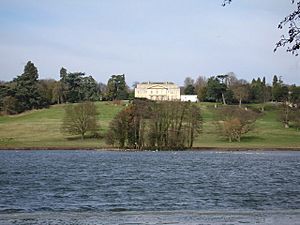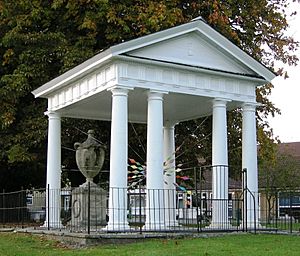Gatton Park facts for kids
Quick facts for kids Gatton Park |
|
|---|---|

Gatton Hall surrounded by Gatton Park
|
|
| Type | Country estate |
| Location | Gatton, Surrey |
| OS grid reference | TQ2749052824 |
|
Listed Building – Grade II
|
|
| Official name: Gatton Hall | |
| Designated | 31 March 1977 |
| Reference no. | 1377943 |
| Official name: Lower Gatton Park | |
| Designated | 7 December 1998 |
| Reference no. | 1001409 |
| Lua error in Module:Location_map at line 420: attempt to index field 'wikibase' (a nil value). | |
Gatton Park is a large country estate located near Reigate in Surrey, England. Its beautiful parkland was designed by the famous landscape architect Capability Brown.
Today, The Royal Alexandra and Albert School owns Gatton Park. The estate covers about 250 acres (1 square kilometer) of land. Gatton Park is a very important historical site. It is listed as a Grade II building and its park is also a Grade II listed historic garden. Part of the park is looked after by the National Trust.
Most of Gatton Park is not open to the public. However, there are special days when visitors can explore its grounds.
Contents
Exploring Gatton Park's Past
The history of Gatton Park goes back a very long time. It was first mentioned in the Domesday Book in 1086. This book was a huge survey of England ordered by William the Conqueror.
Early History and Parliament
In 1451, Gatton was given a special right. It could send two members to the English Parliament. This was a big deal for such a small place. Gatton became known as a "rotten borough". This meant it was a place with very few voters, but it still had a lot of power in Parliament. This special right lasted until 1832. That's when the Parliamentary reform of 1832 changed how elections worked.
During the Middle Ages, the land around the main house was used as a deer park. Here, deer were kept for hunting.
Owners and Landscape Changes
In the 17th century, the Weston family owned Gatton Park. Later, around 1748, Sir James Colebrooke bought the estate. His brother, Sir George Colebrooke, hired Capability Brown to design the park. Brown worked on the landscape between 1762 and 1768. He was known for creating natural-looking parks with rolling hills and lakes.
In 1830, Frederick John Monson bought Gatton for a huge sum of money. He mainly wanted it for its right to send members to Parliament. But just two years later, this right was taken away. So, Lord Monson was left with just the land.
Lord Monson decided to make Gatton Hall very grand. He hired architect Thomas Hopper to make changes. The most impressive part was the Marble Hall in the center of the house. It was covered in beautiful marble, even the floor. It was designed to look like a famous chapel in Rome. The walls were painted with pictures of important historical women.
After Lord Monson, the estate was inherited by the 6th Baron Monson. He lived elsewhere and rented out Gatton Hall. One famous renter was Hugh Cairns, 1st Earl Cairns, who was a very important lawyer.
In 1888, Sir Jeremiah Colman bought the estate. His family was famous for making Colman's mustard. During the Second World War, the property was taken over by the government. After the war, The Royal Alexandra and Albert School bought Gatton Park, and they own it today.
St Andrew's Church: A Unique Place of Worship
Close to Gatton Hall is St Andrew's Church. This church was built in the 13th century and is a Grade I listed building. It was mostly a private chapel for the people living at Gatton Hall. You could even reach it from the house through a covered walkway.
In 1834, the church was made much more beautiful inside. Many special wooden pieces were brought from other countries. For example:
- The pulpit and altar came from Nuremberg, Germany. People at the time thought they might have been made by the famous artist Albrecht Dürer.
- Carved doors were brought from Rouen, France.
- The seats for the priests came from a monastery in Ghent, Belgium.
- The altar rails were from Tongeren, Belgium.
- Stained glass windows and carved wood panels came from Aarschot, Belgium.
A beautiful Gothic screen at the west end of the church was saved from being burned. It came from an old English church. A famous expert, Nikolaus Pevsner, once said that Gatton church is like a "jewel box." He meant it was a perfect example of how a church could become an extension of the landlord's home.
In 1930, some stones from the church were given to Colorado College in the United States. They were used in a chapel there to honor an ancestor of Sir Jeremiah Colman.
Other Interesting Features of the Park
Gatton Park has more than just the Hall and the church. There are other fascinating spots to discover.
The "Town Hall"
In the park, you can find a small, square wooden building. It has six columns and looks like a tiny temple. People jokingly call it "Gatton Town Hall." Before 1832, this is where the very few voters of Gatton would cast their votes for Parliament.
Behind this "Town Hall" is a stone urn. It has snakes wrapped around it and a message. The message says it's "in memory of the deceased Borough." This refers to Gatton losing its special voting rights.
The Millennium Stones
You can also find a stone circle in the park called The Millennium Stones. This was created by sculptor Richard Kindersley in 2000. It marks the start of the new millennium. The stones are made from flat flagstones from Scotland.
The first stone has words from St John's Gospel: "in the beginning the word was." The other nine stones have quotes from different periods over the last 2000 years. The last stone has words from the poet T.S. Eliot.




